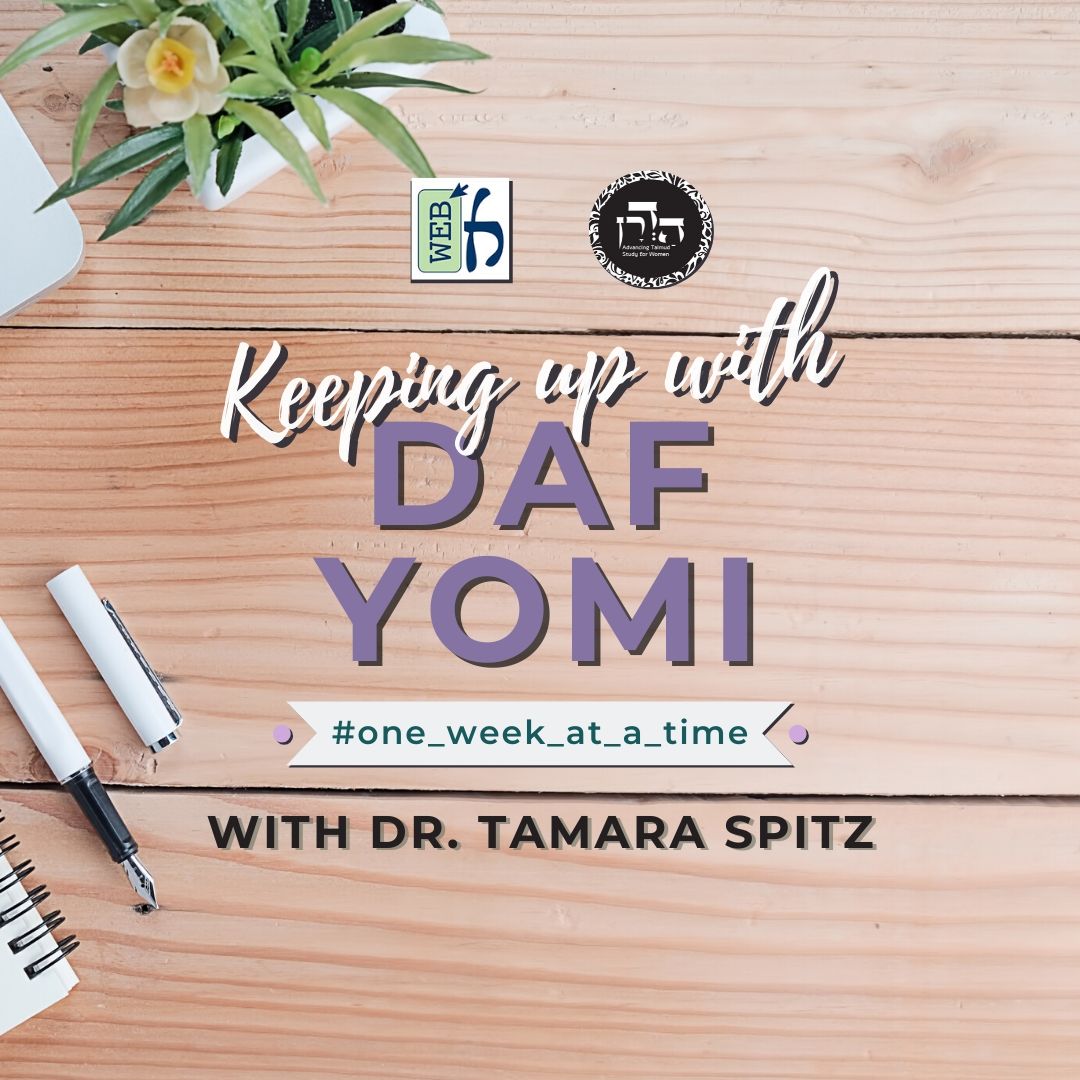A question was asked regarding nullification of sanctity of the sabbatical year when an onion picked in the seventh year was replanted in the eighth year. After a few sources were brought to answer the question in Nedarim 57, the Gemara continues to quote other sources in an attempt to answer the question. Most of the sources and rejected, however in the end, a source is brought from which one can learn that the sabbatical year onion is nullified if replanted in the eighth year. However, how can this be reconciled with the opinions of Rabbi Yochanan and Rabbi Yonatan who brought sources proving the opposite in Nedarim 57? A distinction is made between shmita on the one hand and maaser, orla and mixed breeds.
Want to dedicate learning? Get started here:


Today’s daily daf tools:
Today’s daily daf tools:
Delve Deeper
Broaden your understanding of the topics on this daf with classes and podcasts from top women Talmud scholars.
New to Talmud?
Check out our resources designed to help you navigate a page of Talmud – and study at the pace, level and style that fits you.
The Hadran Women’s Tapestry
Meet the diverse women learning Gemara at Hadran and hear their stories.
Nedarim 58
כׇּל דָּבָר שֶׁיֵּשׁ לוֹ מַתִּירִין, כְּגוֹן טֶבֶל וּמַעֲשֵׂר שֵׁנִי וְהֶקְדֵּשׁ וְחָדָשׁ — לֹא נָתְנוּ בָּהֶן חֲכָמִים שִׁיעוּר. וְכׇל דָּבָר שֶׁאֵין לוֹ מַתִּירִין, כְּגוֹן תְּרוּמָה וּתְרוּמַת מַעֲשֵׂר וְחַלָּה וְעׇרְלָה וְכִלְאֵי הַכֶּרֶם — נָתְנוּ בָּהֶם חֲכָמִים שִׁיעוּר.
For any item that can become permitted, i.e., a forbidden object whose prohibition can or will lapse, for example, untithed produce that can be permitted through tithing, and second tithe that is permitted through redemption or bringing it to Jerusalem (Deuteronomy 14:24–26), and consecrated items that are also permitted through redemption, and produce of the new crop that is permitted after the sacrifice of the omer offering (Leviticus 23:14), the Sages did not determine a measure for their neutralization, and no mixture with any quantity of permitted items neutralizes their prohibition. And for any item that cannot become permitted, for example, teruma, and teruma of the tithe, and ḥalla (Numbers 15:20–21); fruit of a tree during the first three years after its planting [orla]; and forbidden food crops in a vineyard (Deuteronomy 22:9), the Sages determined a measure for their neutralization.
אָמְרוּ לוֹ: וַהֲלֹא שְׁבִיעִית אֵין לָהּ מַתִּירִין, וְלֹא נָתְנוּ בָּהּ חֲכָמִים שִׁיעוּר. דִּתְנַן: הַשְּׁבִיעִית אוֹסֶרֶת כׇּל שֶׁהוּא בְּמִינָהּ! אָמַר לָהֶן: אַף אֲנִי לֹא אָמַרְתִּי אֶלָּא לְבִיעוּר.
The Rabbis said to Rabbi Shimon: But isn’t Sabbatical-Year produce an item that cannot become permitted, and nevertheless, the Sages did not determine a measure for its neutralization, as we learned in a mishna (Shevi’it 7:7): The Sabbatical-Year produce prohibits permitted produce of its own species with which it is mixed in any amount. Rabbi Shimon said to them: I too said that Sabbatical-Year produce prohibits permitted produce in a mixture and permitted growths that develop from it only with regard to the removal of the produce. Sabbatical-Year produce may be eaten only as long as produce of that species remains in the field, after which it must be removed from one’s possession. Since it is permitted to eat the produce before that time, its legal status during this period is that of an item that can become permitted.
אֲבָל לַאֲכִילָה בְּנוֹתֵן טַעַם. וְדִלְמָא הָא נָמֵי לְחוּמְרָא שָׁאנֵי!
However, with regard to the permissibility of eating Sabbatical-Year produce after the time of removal has passed, when eating that produce is prohibited, the Sages determined a measure for their neutralization. The mixture is forbidden only if the measure of that produce is enough to impart flavor to the mixture. Apparently, permitted growths can neutralize the prohibition of the original item. The Gemara rejects the proof: And perhaps here too, it is different when the ruling is a stringency. In this case, the stringency is that the original item is sacred with the sanctity of the Sabbatical Year. However, here too, there is no proof that the same would be true in cases where the result is a leniency.
אֶלָּא מִן הָדָא פַּשְׁטַהּ, דִּתְנַן: בְּצָלִים שֶׁיָּרְדוּ עֲלֵיהֶם גְּשָׁמִים וְצָמְחוּ, אִם הָיוּ עָלִין שֶׁלָּהֶן שְׁחוֹרִין — אֲסוּרִין. הוֹרִיקוּ — מוּתָּרִין.
Rather, Yishmael of Kefar Yamma resolved his dilemma from this source, as we learned in a mishna (Shevi’it 6:3): With regard to sixth-year onions upon which rain fell during the Sabbatical Year, and they sprouted, if their leaves were black [sheḥorin], i.e., dark green, an indication of fresh, recent growth, the onions are forbidden as Sabbatical-Year growth. If their leaves turned green [horiku], i.e., lighter and yellower, and appeared withered, the onions are permitted, as they are considered a product of the sixth year.
רַבִּי חֲנַנְיָא בֶּן אַנְטִיגְנוֹס אוֹמֵר: אִם יְכוֹלִין לִיתָּלֵשׁ בֶּעָלִין שֶׁלָּהֶן — אֲסוּרִין. וּכְנֶגְדָּן, לְמוֹצָאֵי שְׁבִיעִית — מוּתָּרִין. לְמֵימְרָא דְּגִידּוּלֵי הֶיתֵּר מַעֲלִין אֶת הָאִיסּוּר. וְדִלְמָא בִּמְדוּכָּנִין.
Rabbi Ḥanina ben Antigonus says: There is a different indicator; if the plants can be uprooted by their leaves, clearly the leaves are fresh and recent, and they are forbidden. And in the parallel situation, if that indicator was discovered in a Sabbatical-Year onion that sprouted at the conclusion of the Sabbatical Year, i.e., during the eighth year, the onions are permitted. The Gemara asks: Is this to say that one may conclude from here that permitted growth neutralizes the prohibition of the original plant? The Gemara rejects this conclusion: And perhaps the halakha is with regard to crushed [medukhanin], pounded onions, and the reason that the prohibition of the original plant is neutralized is not that the permitted growth neutralizes the prohibition, but that it is no longer fit for consumption.
אֶלָּא מִן הָדָא, דְּתַנְיָא:
Rather, the dilemma can be resolved from this source; as it is taught in a baraita:
הַמְנַכֵּשׁ עִם הַכּוּתִי בַּחֲסִיּוֹת — אוֹכֵל מֵהֶן אֲכִילַת עֲרַאי, וּמְעַשְּׂרָן וַדַּאי.
One who weeds ḥasayot with a Samaritan may eat a casual meal from them without tithing, as any untithed produce may be eaten in the framework of a casual meal. And when he completes the labor on the ḥasayot, places them into a pile, and they require tithing, he tithes them as produce that is definitely obligated in tithing, not as doubtfully tithed produce, as the assumption is that the Samaritan did not tithe the ḥasayot.
רַבִּי שִׁמְעוֹן בֶּן אֶלְעָזָר אוֹמֵר: אִם יִשְׂרָאֵל חָשׁוּד עַל הַשְּׁבִיעִית, לְמוֹצָאֵי שְׁבִיעִית — מוּתָּר. לְמֵימְרָא דְּגִידּוּלֵי הֶיתֵּר מַעֲלִין אֶת הָאִיסּוּר, וְדִלְמָא בְּדָבָר שֶׁזַּרְעוֹ כָּלֶה? הָא תַּנְיָא: אֵלּוּ הֵן חֲסִיּוֹת — כְּגוֹן הַלּוּף הַשּׁוּם וְהַבְּצָלִים.
Rabbi Shimon ben Elazar says: If the ḥasayot belong to a Jew who is suspect about observance of the Sabbatical Year, at the conclusion of the Sabbatical Year it is permitted to weed with him, as there is no concern that there might be Sabbatical-Year sanctity. The Gemara asks: Is this to say that the permitted growths of the eighth year neutralize the prohibition, and that is why there is no concern about Sabbatical-Year sanctity? The Gemara rejects that inference: And perhaps the tanna is speaking with regard to an item whose seeds cease after it is sown, whose growths neutralize the original prohibition? The Gemara rejects that possibility: Isn’t it taught in a baraita: These are ḥasayot, for example, arum, garlic, and onions, whose seeds do not cease?
וְדִלְמָא בִּמְדוּכָּנִין? ״חָשׁוּד עַל הַשְּׁבִיעִית״ קָתָנֵי. וְדִלְמָא בְּתַעֲרוֹבֶת? הַמְנַכֵּשׁ קָתָנֵי.
The Gemara asks: And perhaps the tanna is speaking with regard to plants that were crushed before they sprouted growths? The Gemara answers: It is the case of one who is suspect about observance of the Sabbatical Year, that is taught in the baraita, and one who is suspect would not bother to eliminate the prohibition by crushing it. The Gemara asks: And perhaps the tanna is speaking with regard to a mixture of forbidden ḥasayot and permitted ones, and the reason that it is permitted is that the prohibition was neutralized by the majority of permitted ḥasayot? The Gemara answers: One who weeds, is taught in the baraita, indicating that he is eating the leaves as he weeds them, leaving no opportunity for the ḥasayot to be mixed with others.
לֵימָא תֶּיהְוֵי תְּיוּבְתֵּיהּ דְּרַבִּי יוֹחָנָן וּדְרַבִּי יוֹנָתָן! אָמַר רַבִּי יִצְחָק: שַׁנְיָא שְׁבִיעִית, הוֹאִיל וְאִיסּוּרָהּ עַל יְדֵי קַרְקַע — בְּטִילָתָהּ נָמֵי עַל יְדֵי קַרְקַע.
The Gemara suggests: Let us say that this is a conclusive refutation of the opinions of Rabbi Yoḥanan and Rabbi Yonatan, who stated regarding orla and food crops in a vineyard that their permitted growth does not neutralize the prohibition of the original fruit or food crops respectively. Rabbi Yitzḥak said: The Sabbatical-Year produce is different. Since its prohibition is engendered by means of the ground, its nullification is effected by means of the ground as well. The prohibition can be neutralized by means of the growth that results from replanting the forbidden plant in a permitted manner.
הֲרֵי מַעֲשֵׂר, דְּאִיסּוּרוֹ עַל יְדֵי קַרְקַע, וְאֵין בְּטִילָתוֹ עַל יְדֵי קַרְקַע. דְּתַנְיָא: לִיטְרָא מַעֲשֵׂר טֶבֶל שֶׁזְּרָעָהּ בַּקַּרְקַע וְהִשְׁבִּיחָה, וַהֲרֵי הִיא כְּעֶשֶׂר לִיטְרִין — חַיֶּיבֶת בְּמַעֲשֵׂר וּבִשְׁבִיעִית. וְאוֹתָהּ לִיטְרָא, מְעַשֵּׂר עָלֶיהָ מִמָּקוֹם אַחֵר לְפִי חֶשְׁבּוֹן!
The Gemara asks: Isn’t there the case of tithe, whose prohibition is engendered by means of the ground, but its nullification is not effected by means of the ground? As it is taught in a baraita: With regard to a litra of untithed first tithe from which the teruma of the tithe was not taken, which one sowed in the ground, and it grew and it is now approximately ten litra, that additional growth is obligated to have tithe taken and is subject to the halakhot of Sabbatical-Year produce. And with regard to that original litra of untithed first tithe that he sowed, one tithes for it from produce in a different place, and not from the litra itself, based on a calculation of how much teruma of the tithe needed to be taken from that litra. Apparently, the growth that results from sowing the first tithe in the ground does not neutralize its prohibition.























